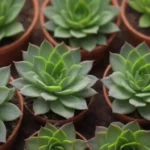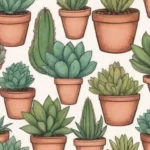
A Beginner’s Guide to Indoor Succulent Watering Frequency

Introduction
Succulents are captivating plants that have skyrocketed in popularity over the past decade. Known for their unique shapes, vibrant colors, and low maintenance needs, they are often the perfect choice for indoor gardening enthusiasts and busy individuals alike. However, one critical aspect of succulent care remains a mystery to many: watering frequency. Understanding how often to water these hardy plants can significantly impact their health, growth, and overall vitality.
This article aims to demystify the proper watering frequency for indoor succulents, ensuring you have the knowledge necessary to keep your plants thriving. We will explore the unique needs of succulents, the signs of overwatering versus underwatering, effective techniques to determine the right time to water, and tips for creating an optimal watering schedule tailored to your specific plant varieties.
Understanding the Unique Needs of Succulents
Succulents are a diverse group of plants that have adapted to conserve water, making them well-suited for arid environments. Their fleshy leaves and stems store moisture, allowing them to survive long periods without watering. Despite this remarkable ability, improper watering can lead to significant issues, such as root rot and leaf drop. Therefore, understanding their unique watering needs is essential.
Watering Needs of Different Succulent Types
Different types of succulents have varying watering requirements based on their native habitats. For instance, Aloe vera, which originates from tropical regions, may crave more moisture compared to desert-dwelling succulents like Echeveria or Haworthia. Generally, it is crucial to familiarize yourself with the specific types of succulents you have in your collection, as their individual needs can significantly affect how often they should be watered.
Moreover, the size and age of the succulent also play vital roles in determining watering frequency. Younger plants or smaller succulents typically require less water than their larger, more established counterparts since they have less capacity to store moisture. Being aware of these distinctions can help you customize your watering routine effectively.
Factors Affecting Watering Frequency
Several environmental factors impact how often you should water your succulents. Light exposure stands out as one of the main elements influencing succulent hydration. Plants that receive bright, indirect sunlight may require more frequent watering than those located in low-light conditions.
The temperature and humidity levels in your space also have a significant effect. Warmer temperatures often lead to faster evaporation of moisture, necessitating more frequent watering, whereas cooler or more humid environments may extend the time needed between watering sessions. It’s important to observe these conditions to establish a well-informed watering schedule.
 Understanding Indoor Succulents: Basic Care and Maintenance Tips
Understanding Indoor Succulents: Basic Care and Maintenance TipsIdentifying Signs of Overwatering and Underwatering
Knowing how to identify the signs of both overwatering and underwatering is crucial for the health of your succulents. These symptoms can sometimes overlap, making it essential to closely monitor your plants daily.
Signs of Overwatering
Overwatering is one of the most common causes of succulent demise. When you give your succulent too much water, the roots can become waterlogged, leading to root rot and subsequent leaf health deterioration. Signs of overwatering include yellowing leaves, which may also feel soft and mushy. If your plant appears to have swollen leaves or dark patches, it is a clear indicator that excess moisture is a problem.
Another telltale sign is when the lower leaves begin to drop off. This shedding is a natural response as the plant tries to get rid of decaying tissue to conserve energy. If you notice these signs, it’s essential to reduce watering immediately and allow the soil to dry out thoroughly before the next watering.
Signs of Underwatering
Conversely, underwatering can also lead to serious issues for your succulents. An under-watered plant often exhibits wrinkled or shriveled leaves as it begins to lose stored moisture. Leaves may also feel unusually firm or dry to the touch, indicating that the plant is stressed due to lack of water. If you spot these symptoms, it’s essential to adjust your watering schedule, providing the appropriate amount of moisture to help rejuvenate your plant.
Sometimes, you may also notice that the tips of the leaves brown or develop a crispy texture. This is an indication that the succulent is not receiving enough water to sustain itself. When you observe these signs, you should water your plant thoroughly and monitor its progress. A consistent watering schedule typically resolves such issues.
Balancing Water Needs
Achieving a healthy balance between overwatering and underwatering can be challenging, particularly for beginners. To avoid common pitfalls, it is essential to adopt an observe and adapt approach by paying close attention to your plants’ behaviors and conditions. Over time, you will develop a keen sense of your succulents’ water needs, allowing you to select an appropriate watering frequency that suits the specific characteristics of your plant collection.
Effective Techniques to Determine the Right Time to Water

 Indigenous Indoor Succulents to Consider for Your Home Decor
Indigenous Indoor Succulents to Consider for Your Home DecorAssessing when to water your indoor succulents requires an understanding of both visual cues and tactile methods. Here are some effective strategies to help you determine the right time for watering.
The Finger Test
One simple method for assessing soil moisture is the finger test. Stick your finger about one inch into the soil (or more if the pot is large) to check for moisture levels. If the soil is dry to the touch, it’s generally time to water. If it feels damp or muddy, you should hold off for a few more days. This technique is particularly useful for those who are just starting out, as it requires minimal tools and experience.
Soil Moisture Meters
For those who prefer a more precise approach, soil moisture meters are fantastic devices that can help you gauge moisture levels accurately. These tools can provide real-time readings on how moist the soil is, allowing you to make informed decisions as a result. They are particularly beneficial for individuals who may be prone to overwatering or needing reassurance.
Creating a Watering Schedule
Deciding on a watering schedule can provide structure to your succulent care routine. Typically, a good rule of thumb is to water once every two weeks during spring and summer, when succulents are actively growing, and reduce it to once a month during fall and winter when they enter dormancy. However, be sure to adapt this guideline based on achieved soil moisture, temperature, and the unique needs of your plants.
Conclusion
Understanding the watering frequency for indoor succulents is an essential aspect of maintaining their health and vitality. By grasping their unique needs, identifying signs of overwatering versus underwatering, employing effective techniques to assess moisture levels, and establishing a tailored watering schedule, you are well on your way to becoming a proficient succulent caregiver.
Additionally, patience and keen observation are key in this journey. It may take some time to understand the specific nuances of your plants, but with consistent care and attention, you will cultivate a thriving indoor garden filled with beautiful, flourishing succulents. Consider documenting your observations and adjusting your practices as needed; this journaling can track which methods work best for you and your plants.
In conclusion, while succulents are indeed low-maintenance, they still require thoughtful care and attention. Happy gardening, and may your indoor succulents flourish with health and beauty for years to come!
 How to Create a Vertical Garden with Indoor Succulents
How to Create a Vertical Garden with Indoor SucculentsIf you want to read more articles similar to A Beginner’s Guide to Indoor Succulent Watering Frequency, you can visit the Indoor succulents category.



You Must Read